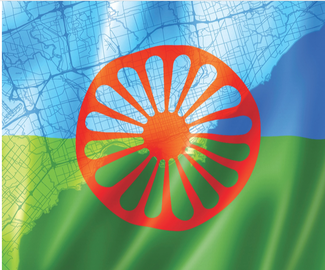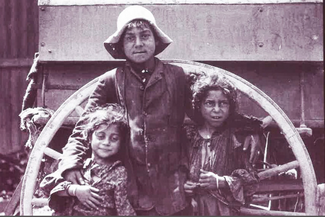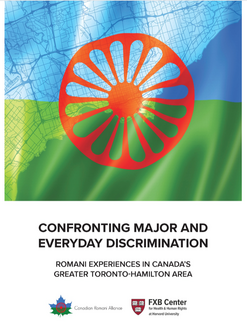Canadian Roma: A People Uncounted

A ground-breaking Harvard University Study investigates the lived experiences of Canadian Roma for the first time.
Despite a long-standing historical presence in Canada, knowledge of the existence of Romani Canadians, their history, culture and contributions, as well as the context and cultural diversity and nuances that comprise the collective Romani identity, remains widely unknown in Canadian society.
Harvard University’s ground-breaking study of Canadian Roma, identifies a “people uncounted” is the first ever analysis that measures both major and everyday discrimination experienced by Romani living within Greater Toronto and Hamilton (GRTH) areas in Ontario, Canada.
This study examined previously uncounted experiences of everyday discrimination. That is to say, the daily experiences of ethno-racial insults, jokes, stereotype-based questioning, passive or active distancing. Issues of low self-, involving incidents where Romani people are misunderstood, underestimated, overlooked, or ignored. The findings from this study reflect the importance of elevating the narratives and experiences of Romani people because they highlight the ways in which subtle indignities can ostracize an individual to the point of self-effacement.
The research team interviewed 87 Canadians (64 Romani adults and 23 non-Romani adults), with the majority of Roma being emigrants or refugees from Central and Eastern Europe. More than half of these Romani participants, have personally experienced acts of major discrimination.

Roma have been in Canada since four or more generations ago and ever since the late 1800s. As one of the study’s participants I am a relatively new Canadian, emigrating from the U.K. to Canada 47 years ago. According to Romani-Canadian author Ronald Lee, Roma arrived as early as 1880 with the men mainly being employed in horse trading and as coppersmiths, and the women usually found employment as fortune tellers, midwives, and herbalists.
Today, many of the Roma diaspora in Canada were descended from settlements in Alberta around 1902, who were described as the descendants of Romani slaves from the Romanian principalities of Wallachia and Moldavia. Gypsies have also been noted in the following places: in 1895 Gypsies arrived at Lunenburg Nova Scotia (it was said for the first time) and pitched their tents in Mr. N. Kaulbach’s pasture. Others came to the Muskoka region of Ontario somewhere between 1885 and 1895. Some were recorded moving through Lanark County, Ontario between 1890 and 1930 often selling door to door, articles of their handiwork, making trades for food such as produce, meat, and even for children’s clothing. Bulgarian Romani were encountered in Innisfil, Alberta in 1904, and Serbian Gypsies in York Mills, Ontario in the early years of the last century. Bohemians, or Gypsies were found in Saint-Jean-sur-Richeliu, Quebec as early as 1905. In 1909, a newspaper reported on a vitsa of Roma of about 90 members who used Peterborough, Ontario as a stopping place, providing both amusement and alarm from local townspeople. The Evening Standard reported, “literally thousands of people” visited the Roma encampment, some arriving in carriages, others in automobiles, the rest on foot, to stand and watch while the Romany women went about the ordinary business of preparing supper.” The alarm happened when “the Ottawa Children’s Aid Society were called when someone thought two of the children were too fair to be Roma.”

A lot has changed from a century ago. Dr. Cynthia Levine-Rasky offers that in Canada today, the Romani comprise “a dynamic and pluralistic community numbering about one hundred thousand and encompassing citizens of many faiths, occupations, and statuses.” She continued that “among Roma who came to Canada, the most common groups include the Kalderdash, from what is now Romania; the Romanichal from the United Kingdom; Gitano and Sinti or (Manouche) from central and western Europe; and various divisions of Romungro, who originated mainly from Hungary. Anecdotally, we have Welsh Kale families, numbering three. I also know of Irish and Scottish Travellers living in Canada.
Canada is a country where equality and multicultural diversity are inscribed in our Constitution. Indeed, these freedoms protect a number of rights and freedoms, including freedom of expression and the right to equality. It forms part of our Constitution – the Charter of Rights and Freedoms. And yet ironically, this study noted there is a need to move beyond statements of diversity towards more cultural sensitivity education in the workplace and in educational and medical settings. The action the study identified is the need for “investing more resources in anti-racism education and policies, alongside Roma-led initiatives such as co-centering Romani voices and Roma-related issues, which span a wide-range of social and institutional settings.”
Played out in the personal lives of many participants, this cultural sensitivity is about how the majority of Romani respondents experienced a least one assault on their worth; quoting from the study, “power is essential to the social production of stigma.” Consequently, the incidents of reported stigmatizing acts or “assaults on worth” among the Romani population in Canada is “evidence of the existence of ingrained and interlinked institutional, societal, and individual hierarchies and power dynamics that have persisted against Romani people.”

Familiar and parallel to many Roma in the U.K. is that among all experiences of everyday discrimination cited, Canadian Romani respondents were more likely to report incidents of feeling ignored or being misunderstood. There’s an intersectionality between the lack of actual awareness of the existence of Romani people by most non-Romani Canadians (most non-Romani respondents did not know much about Romani history, culture, and practices) and the stereotypes relating to Romani people as “criminals or mystics.” Canadians tend to “romanticize Roma as well as the Romani people and culture, by assuming an idealized and idyllic life of traveling, dancing, and fortune-telling, embellished with flowing and colorful outfits and a sense of magic.”
In that context, Canadians associate the terms Roma and Bohemians with representations of free-spirited individuals. When identifying as Roma I too have experienced micro aggressions about crime – “have you been in prison?”, and fortune telling – “that’s Satan’s work”. The study notes that here in Canada, we Romani are perceived as a “collective identity, closely aligned with and mirroring the perceptions, characterised as one connected to “nomadic” and “traveling” people” that remains instilled” and inured through the lens of these dominant narratives and perceptions.
One of the benefits of this study is that it contributes to a scarce body of Roma-led and Roma-related literature in Canada. For this Roma author, the publishing culture for Roma authors has only recently opened up to us. For example, five years ago I could only find a publisher in Wales for my book, Parramisha: A Romani Poetry Collection (2020). Meanwhile this year in Canada, Lynn Hutchison Lee has published her novel, Nightshade (2026) and her novella, Origins of Desire in Orchid Fens (2025). Whilst my memoir, Akekoi: A Romani Memoir (2026) has also found a Canadian publisher. These are the first Roma literature books ever to be published by Roma in Canada since Dr. Ron Lee’s Goddam Gypsy (1984) republished as Living Fire (2009). Fortunately, this Harvard University study is now contributing to our previously scarce body of Roma-led and Roma literature in Canada.
The study draws a conclusion that highlights the stark contrast between the level of awareness of Roma realities, on the one hand, and familiarity with familiar racializing images often associated with the “slur G*psy.” The findings suggest that being misunderstood reaffirmed decisions by the study’s participants to repress or hide our Romani identities. I did this with my doctor, unaware that I’d kept my Roma identity hidden because it came with me from the U.K.

However, the benefits of the Harvard University’s study, include research findings that apply to attitudes regarding racism towards Roma from East Europe, informing legal precedents set under Bill C-31 that governs immigration and refugee jurisdictions, including the controversial “safe country” classification. This means that deportation of Roma is still occurring, particularly to Romania as in the case of the Lordache family who in 2023 drowned crossing the border to America while attempting to avoid deportation to a country where housing, education and healthcare were often denied to Roma. Immigration remains a hot button issue.
At the federal level, the Canadian Parliament across all parties has acknowledged August 2nd as the official day of commemoration and remembrance for the Roma Holocaust. This is only a start. There is more advocacy work to be done, with voices, particularly from East European Roma being heard and incorporated into policy and research. This work is ongoing by the Canadian Romani Alliance under the leadership of Gina Csanyi-Robah who spearheaded and partnered with Harvard University FXB, making a significant contribution to this newly and powerfully realised body of knowledge about Canadian Roma.

Published in September 2024, the study contributors are: Dr. Margareta Matache, director of the FXB Center for Health and Human Rights’ Roma Program. Stephanie Martinez-Fernandez, Edita Rigova, Aqil Arif Merchant, Keisha Bush, Jacqueline Bhabha of Harvard University. Gina Csanyi-Robah, Executive Director of Canadian Romani Alliance, Shayna Plaut Director of Research and Exhibition Development, Canadian Museum for Human Rights.
For more information: https://fxb.harvard.edu/2024/09/23/new-report-confronting-major-and-everyday-discrimination-romani-experiences-in-canadas-greater-toronto-hamilton-area/
Frances Roberts Reilly for Travellers Times News
(All images sourced by Frances Roberts Reilly)
